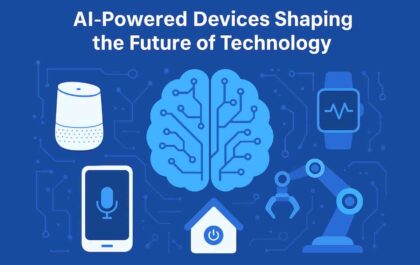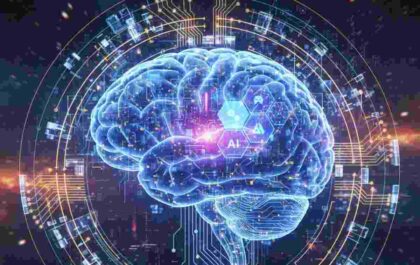Artificial Intelligence (AI) is no longer a futuristic concept—it’s a driving force behind the biggest technological shifts of the 21st century. From smart homes and virtual assistants to autonomous vehicles and healthcare robots, AI-powered devices are redefining how humans interact with technology. On platforms like SmartTechCrunch.com, discussions around AI innovation have become essential to understanding the digital transformation shaping industries today.
Table of Contents
The Rise of AI-Powered Devices
AI has evolved from simple automation to intelligent decision-making. Modern AI-powered devices can analyze vast amounts of data, learn user behavior, and make independent predictions. This evolution has been fueled by advancements in machine learning, neural networks, and natural language processing.
Some of the most common examples include:
-
Smartphones that recognize your face, voice, and habits.
-
Wearables that track your health metrics and predict potential health risks.
-
Smart home devices like Alexa or Google Home that understand your preferences.
-
AI-driven security systems capable of identifying intruders or unusual activity.
What makes these devices revolutionary is their ability to learn and adapt. Unlike traditional machines, AI-powered devices improve over time, becoming more personalized and efficient.
AI in Everyday Life
The beauty of AI lies in its invisibility. It’s not just present in high-end robotics or industrial tools — it’s in the little things that make daily life easier.
-
Smart Assistants: Siri, Alexa, and Google Assistant now do more than answer questions. They manage schedules, send messages, control appliances, and even suggest actions before users think of them.
-
Healthcare Devices: Smartwatches and medical wearables now detect heart rate abnormalities or blood oxygen levels, alerting users and doctors in real time.
-
Transportation: Cars like Tesla are powered by advanced AI that enables semi-autonomous driving, lane detection, and predictive maintenance.
-
Retail and E-commerce: AI-powered devices in stores use facial recognition to identify customers, track preferences, and enhance the shopping experience.
AI is transforming the way technology fits into our lifestyles — making devices not just smart, but aware.
How AI is Revolutionizing Industries
-
Healthcare:
AI-powered medical devices can analyze scans, detect diseases earlier, and assist surgeons with precision operations. Predictive AI helps hospitals manage patient data efficiently and reduce errors. -
Manufacturing:
Robots equipped with AI handle complex assembly tasks, detect defects, and optimize production lines without human supervision. -
Education:
Smart education tools use AI to personalize learning paths. Devices like AI tutors can assess a student’s strengths and weaknesses and adapt content accordingly. -
Finance:
AI-driven devices and apps monitor market trends, automate investments, and detect fraudulent transactions within seconds. -
Entertainment:
Streaming platforms like Netflix and Spotify rely heavily on AI algorithms to suggest what users might enjoy next — creating a more engaging and personalized experience.
AI and the Future of Work
AI-powered devices are transforming workplaces by automating repetitive tasks. Virtual meeting assistants now take notes, summarize discussions, and even analyze employee sentiment. Businesses using AI tools are witnessing increased productivity, reduced costs, and improved decision-making.
However, this transformation also brings challenges. The fear of job displacement is real, especially in industries like manufacturing and logistics. Yet experts suggest that while AI may replace some roles, it will also create new opportunities in AI management, data analysis, and human-machine collaboration.
Challenges and Ethical Concerns
Despite its advantages, the rapid integration of AI devices raises several ethical questions:
-
How much personal data should devices be allowed to collect?
-
Can AI make fair decisions without bias?
-
Who is responsible if an AI-driven device makes a mistake?
Regulators worldwide are now discussing AI ethics to ensure transparency, accountability, and fairness. For instance, Europe’s AI Act aims to standardize how companies use AI, ensuring that privacy and safety are never compromised.
At SmartTechCrunch, understanding these nuances is crucial. As the technology evolves, so must our awareness of its implications.
What Lies Ahead for AI-Powered Devices
The next generation of AI devices will likely blend seamlessly into human environments. Imagine:
-
Smart glasses that overlay real-time information on your vision.
-
AI-driven appliances that learn your daily routines and optimize energy usage.
-
Neural interfaces that connect the human brain directly with machines.
AI-powered devices will not only assist humans but also augment human intelligence. The boundary between man and machine will blur — creating a world where AI becomes an extension of human capability.
Conclusion
AI-powered devices are redefining innovation in every sense. They are faster, smarter, and more adaptive than ever before. From improving healthcare outcomes to enhancing daily comfort, AI’s influence is growing across all domains.
The challenge now is not about adopting AI — but how responsibly we integrate it into society. The future belongs to those who balance innovation with ethics, creativity with control, and intelligence with humanity.
In this evolving digital landscape, SmartTechCrunch.com continues to spotlight the latest developments and trends that shape our AI-driven world. As technology races ahead, one thing is certain — AI-powered devices aren’t just changing the future; they are the future.
AI-Powered Devices: Shaping the Future of Technology
Related posts
Featured Posts
AI-Powered Devices: Shaping the Future of Technology
Artificial Intelligence (AI) is no longer a futuristic concept—it’s a driving force behind the biggest technological shifts of the 21st…
NeuroLink AI: The Future of Human–Machine Connection
In the fast-evolving world of technology, NeuroLink AI stands at the forefront of innovation — merging artificial intelligence with the…


